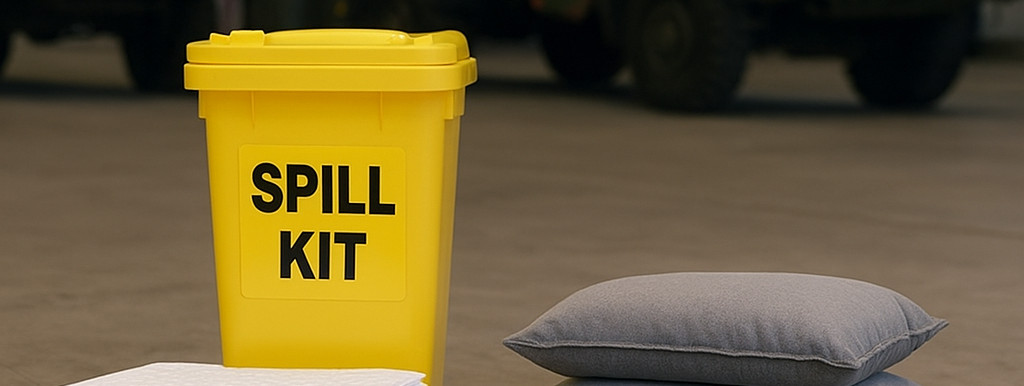
Using Spill Kits and Absorbents in Defence Industries: A Comprehensive Guide
Introduction
Spills of fuels, oils, solvents and other hazardous liquids present unique challenges within defence industry facilities—from airbases and naval docks to armouries and maintenance depots. Rapid containment and safe clean-up are crucial to protect personnel, equipment and the environment, while ensuring operational readiness. This guide provides detailed, sector‑specific best practices for choosing, positioning and using spill kits and absorbents in military and defence contexts.
1. Importance of Spill Management in Defence Settings
Defence installations handle large volumes of petroleum‑based fuels, hydraulic fluids, de‑icing agents and cleaning solvents. Uncontrolled leaks or accidental releases can cause:
- Safety Risks: Slips, trips and chemical exposure threaten the health of technicians, engineers and support staff.
- Operational Delays: Decontamination procedures interrupt maintenance schedules for aircraft, armoured vehicles and naval vessels.
- Environmental Damage: Proximity to military airstrips, coastal zones and training ranges increases risk of groundwater contamination and ecological harm.
- Regulatory and Reputation Impact: National environmental laws and international defence agreements impose strict penalties for pollution events.
2. Regulatory Framework and Compliance
Defence organisations must comply with:
- Environment Act 2021: UK‑wide standards for pollutant discharge and habitat protection.
- Control of Substances Hazardous to Health (COSHH) Regulations: Requirements for risk assessment, training and control measures.
- Ministry of Defence (MOD) Defence Environment and Sustainability Strategy: Sector‑specific guidance on pollution prevention and waste management.
Implementing spill kits aligned with these regulations ensures legal compliance and safeguards defence mission continuity.
3. Types of Spill Kits & Absorbents
3.1 Oil‑Only Kits
Optimised for hydrocarbon-based fluids such as aviation fuel, diesel and lubricants. Hydrophobic absorbents soak up oils while repelling water—ideal on rain‑prone airfields or marine dockyards.
3.2 Chemical‑Resistant Kits
Contain special pads and granules that resist breakdown by aggressive solvents, acids or alkalis used in weapon maintenance and decontamination stations.
3.3 Universal Kits
Versatile kits for mixed spills (water‑based coolants plus oil). Though less efficient than specialised absorbents, they are useful in multi‑hazard workshops and field‑repair units.
3.4 Bulk Absorbents (Granules & Pillows)
High‑capacity granules are scattered over large spills; pillows quickly absorb leaks from tanks, pumps and valve manifolds during routine servicing.
4. Selecting the Right Kit
- Assess Hazardous Fluids Inventory: Make a detailed list of fuels, hydraulic fluids, cleaning agents and gun‑cleaning solvents on site.
- Estimate Maximum Spill Volumes: Consider tanker sizes, vehicle fuel capacities and bulk storage volumes in hanger and depot areas.
- Identify High‑Risk Zones: Refuelling points, engine test cells and ordnance cleaning bays require immediate spill‑response access.
- Choose Appropriate Absorbent Type: Match kit to the fluid properties—oil‑only, chemical resistant or universal.
- Determine Kit Capacity: Ratings typically range from 25 L to 200 L. Always overspecify by 20 % to accommodate worst‑case releases.
5. Strategic Positioning and Accessibility
To guarantee swift response:
- Deploy Kits Nearest Refuelling Points: Wall‑mounted or wheeled bins at all jet fuel pumps, diesel bowser stations and vehicle fleet yards.
- Location Signage: High‑visibility labels or coloured markings for rapid identification under low‑light or high‑stress conditions.
- Use Spill Stations: Dedicated spill response lockers containing absorbents, PPE and disposal bags in each workshop and hangar.
6. Standard Operating Procedure (SOP) for Spill Response
6.1 Immediate Action
- Isolate ignition sources—shut off engines and electrical equipment.
- Raise the alarm: inform site control, safety officer and, if required, environmental authorities.
- Cordon off the affected area and prevent foot and vehicle traffic.
6.2 Containment and Absorption
- Use absorbent socks or booms to stop spread toward drains or sensitive zones.
- Apply pads directly on the spill then granular absorbents around its perimeter.
- Allow dwell time (5–10 minutes) for thorough absorption.
6.3 Collection and Disposal
- Place used absorbents in labelled, leak‑proof disposal bags.
- Log spill details: date, fluid type, volume and response actions.
- Engage accredited waste contractor for hazardous waste removal.
6.4 Decontamination
Clean any residual traces using suitable detergents; capture washings as hazardous liquid waste if contaminated.
7. Training & Competency
All defence personnel involved in maintenance and logistics should undergo:
- Initial Induction Training: Overview of spill types, kit contents and SOP steps.
- Hands‑On Drills: Quarterly practical exercises simulating airfield, workshop or munitions‑site spills.
- Competency Assessments: Written or practical tests, with certification recorded in personnel files.
8. Maintenance & Inspection of Kits
Monthly inspections ensure readiness:
- Check absorbent stock levels and expiry dates.
- Verify PPE integrity (gloves, goggles, coveralls).
- Restock disposal bags, ties and instruction sheets.
- Log inspection results and any replenishment actions.
9. Case Study: Aircraft Hangar Fuel Leak
During routine servicing of a transport aircraft, a hydraulic line failed, releasing 50 L of fluid onto the hangar floor. Pre‑positioned oil‑only spill kits enabled immediate containment:
- Socks ring‑fenced the drain entry.
- Pads and pillows absorbed the bulk fluid in under 8 minutes.
- Waste was bagged and disposed of as hazardous waste, preventing hangar downtime and avoiding environmental fines.
10. Innovations & Future Trends
- IoT‑Enabled Kits: Real‑time inventory monitoring via RFID tags, alerting stores managers before levels run low.
- Biodegradable Absorbents: Plant‑based materials that degrade hydrocarbons, reducing disposal costs and environmental footprint.
- Virtual Reality Training: Immersive spill scenarios in VR to sharpen response skills without using real hazardous liquids.
Conclusion
Effective spill kit deployment and absorbent selection are vital for safe, compliant and uninterrupted operations within defence industries. By integrating robust SOPs, strategic kit positioning, regular training and innovative technologies, military and defence organisations can maintain environmental stewardship and operational readiness, even under the most demanding conditions.
Next Steps: Conduct a site‑wide audit of your spill‑response assets, update your SOPs and schedule your next spill drill to ensure peak readiness.
